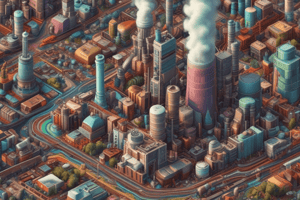Podcast
Questions and Answers
What are PCBs primarily used for?
What are PCBs primarily used for?
- As colorants in paints and dyes.
- As fertilizers in agriculture.
- As a dietary supplement.
- As electrical insulators in transformers and capacitors. (correct)
Which of the following statements about PCBs is true?
Which of the following statements about PCBs is true?
- PCBs are known for their high flammability.
- PCBs can bioaccumulate in the food chain. (correct)
- PCBs are classified as safe for human health.
- PCBs easily break down in the environment.
What regulations exist regarding PCBs?
What regulations exist regarding PCBs?
- There are no international regulations on PCBs.
- Only physical-chemical methods are permitted for PCB disposal.
- The Toxic Substances Control Act regulates PCB disposal. (correct)
- PCBs are freely produced and used.
Which of the following health effects is associated with PCBs?
Which of the following health effects is associated with PCBs?
What remediation technique uses microorganisms to break down PCBs?
What remediation technique uses microorganisms to break down PCBs?
Study Notes
Definition of PCB
- PCB: Polychlorinated biphenyls, a group of synthetic organic chemicals containing 1 to 10 chlorine atoms.
- Used for their non-flammability and chemical stability.
Properties
- Chemical Structure: A biphenyl molecule with chlorine atoms substituted at various positions.
- Physical Characteristics: Colorless or light yellow oily liquids/solids with a mild aromatic odor.
Uses
- Electrical insulators in transformers and capacitors.
- Coolants and lubricants in industrial applications.
- Sealants and adhesives.
Environmental Impact
- Persistence: Very stable, do not easily break down in the environment.
- Bioaccumulation: Accumulate in the food chain, posing risks to wildlife and human health.
- Contamination: Found in soil, water, and air due to improper disposal and leaks.
Health Effects
- Potential health risks include:
- Cancer risk (known carcinogen).
- Hormonal disruption.
- Effects on the immune system.
- Neurological effects, particularly in children.
Regulations and Management
- Banned in many countries since the late 1970s due to health risks.
- The Toxic Substances Control Act (TSCA) in the U.S. regulates PCB disposal and remediation.
- International treaties, such as the Stockholm Convention, aim to eliminate or restrict the production and use of PCBs.
Remediation Techniques
- Physical-chemical methods: Incineration, chemical dechlorination.
- Bioremediation: Use of microorganisms to break down PCBs.
- Containment: Capping or solidification to prevent exposure.
Conclusion
- PCBs are hazardous substances with significant environmental and health impacts.
- Strict regulations are in place to manage and remediate PCB contamination.
Definition
- Polychlorinated biphenyls (PCBs) are a group of synthetic organic chemicals containing 1 to 10 chlorine atoms.
- They are used for their non-flammability and chemical stability.
Properties
- PCBs are composed of a biphenyl molecule with chlorine atoms substituted at various positions.
- These molecules are typically colorless or light yellow, oily liquids or solids.
- They have a mild aromatic odor.
Uses
- Primarily used as electrical insulators in transformers and capacitors.
- PCBs have been used as coolants and lubricants in industrial applications.
- Also implemented as sealants and adhesives.
Environmental Impact
- PCBs are extremely stable and do not easily break down in the environment.
- They bioaccumulate in the food chain, posing risks to wildlife and human health.
- PCBs can be found in soil, water, and air due to improper disposal and leaks.
Health Effects
- PCBs are considered to be carcinogenic, posing a cancer risk.
- They can disrupt hormonal functions, causing a range of adverse effects.
- They can negatively impact the immune system.
- PCBs can cause neurological effects, particularly damaging to children.
Regulations and Management
- The production and use of PCBs have been banned in many countries since the late 1970s due to health risks.
- The Toxic Substances Control Act (TSCA) regulates the disposal and remediation of PCBs in the United States.
- International treaties such as the Stockholm Convention aim to eliminate or restrict the production and use of PCBs globally.
Remediation Techniques
- Several methods exist for remediating PCB contamination: physical-chemical methods, bioremediation, and containment.
- Physical-chemical methods include incineration and chemical dechlorination.
- Bioremediation uses microorganisms to break down PCBs.
- Containment can be achieved by capping or solidifying the contaminated material.
Conclusion
- PCBs pose significant threats to the environment and human health.
- Strict regulations and ongoing remediation efforts are necessary to manage and minimize the impact of PCB contamination.
Studying That Suits You
Use AI to generate personalized quizzes and flashcards to suit your learning preferences.
Description
This quiz covers Polychlorinated biphenyls (PCBs), including their chemical structure, uses in industrial applications, and significant environmental impacts. Understand the health risks and the persistence of PCBs in the environment and their effects on wildlife and human health.




